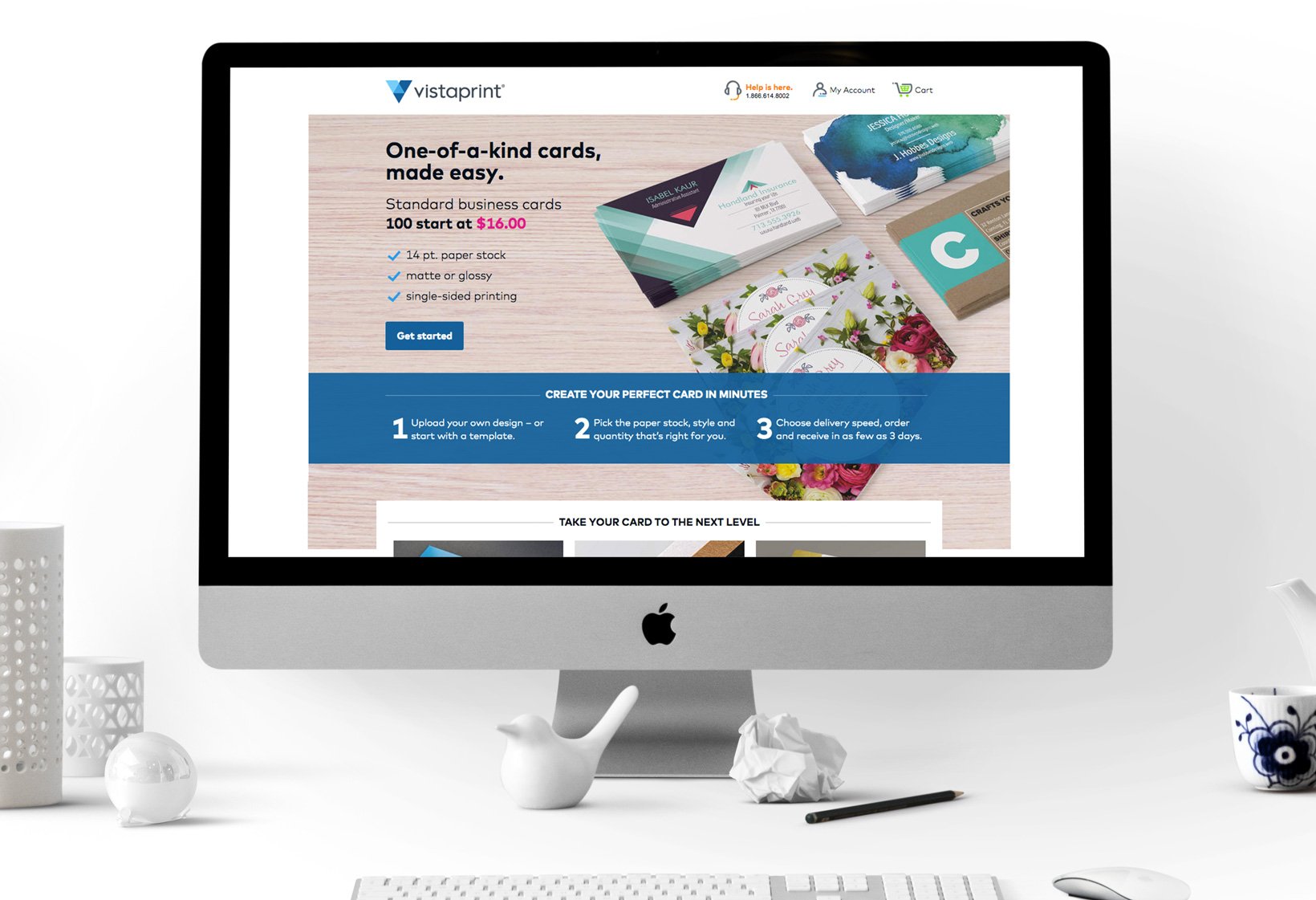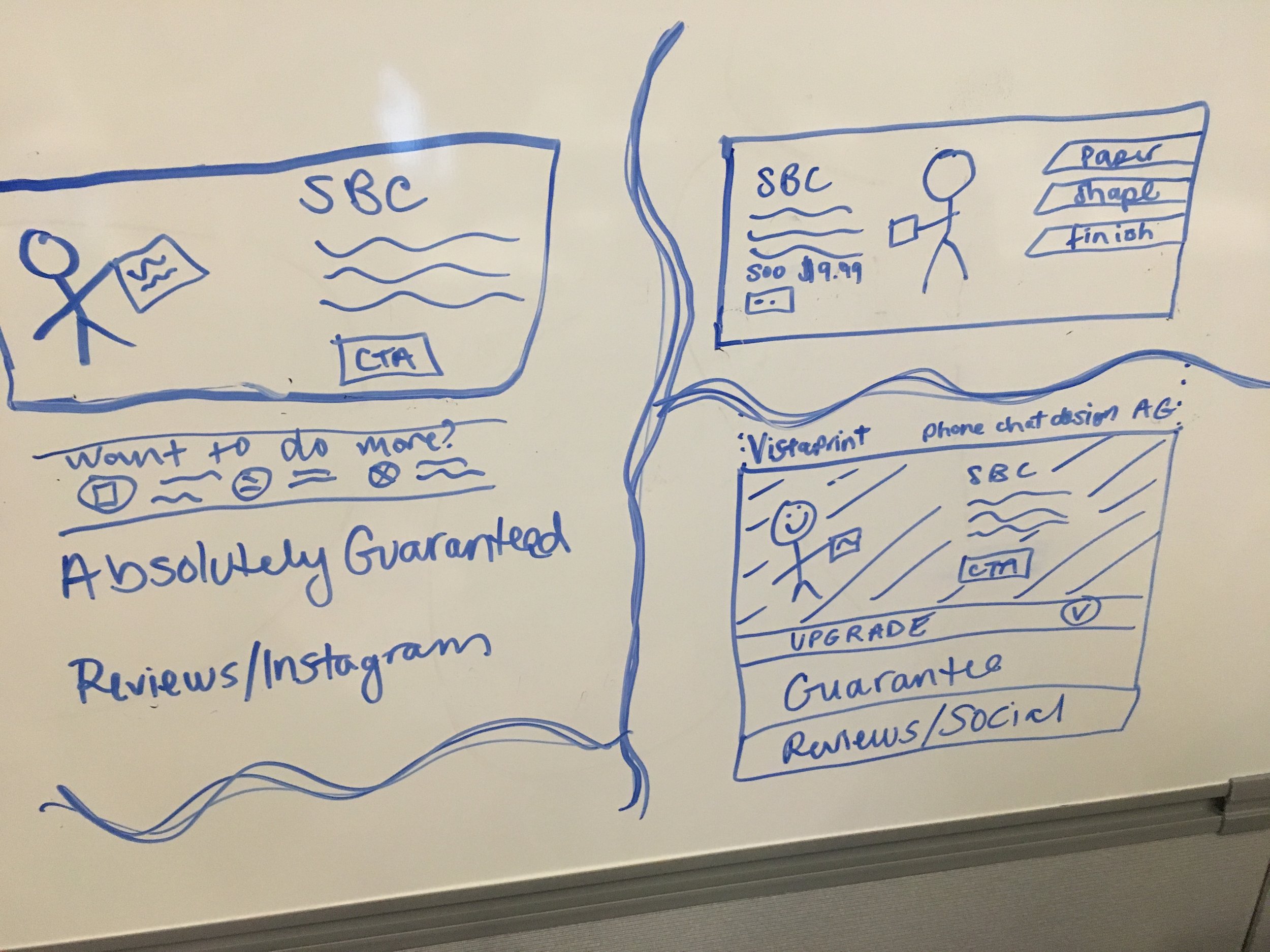VistaPrint — Standard Business Card LP
-
About VistaPrint
VistaPrint helps small business owners and entrepreneurs create a custom and cohesive brand. Their free, templated designs can be used across multiple printed products (e.g. business cards, promotional products, signage, and more) and their online printing services allow users to create and receive them quickly and affordably.
-
Problem Statement
How might we design a global, paid search landing page for business cards that outperforms the current North American and European landing pages and brings more visibility of VistaPrint's product options and add-ons to our customers?
-
TL;DR
The cross-functional team designed high-fidelity prototypes and brought them to moderated focus groups in the United States and parts of Europe for feedback and insights. The pages were optimized with content preference testing and heatmap visualization software before launching an A/B/C test in the U.S. and England. One of the test pages narrowly missed outperforming the control in the U.S. only.
Background:
Business Cards are the most lucrative product across VistaPrint and, unsurprisingly, the North American and European standard business card landing pages had been meticulously tried and tested over the years. The problem is, the team had relied so heavily on multivariate tests (i.e. copy, colors, content) to optimize page performance over the years that the page was left far behind from a brand perspective as the rest of the VistaPrint moved forward.
Our goals were to come together as a cross-functional, worldwide team to create a global landing page for standard business cards that would outperform the current geographic-specific pages, improve the visibility of VistaPrint's product options and add-ons to our customers, and more accurately represent the VistaPrint brand.
My role: Research Contributions, Lead Designer, and Lead Developer.

North American Standard Business Card Landing Page (Control)

European Standard Business Card Landing Page (Control)
Discovery:
User Testing on Control Pages:
We began with moderated click-tests of the current North American and European landing pages to identify any issues with the current flow, gather insights into the customer mindset at this stage of their purchasing process, and to collect functional and aesthetic preferences.
Collecting Comprehensive Customer Insights:
A global team of product owners, researches and user experience designers came together to share customer insights and trends collected from all research efforts across VistaPrint.
Competitor Research:
An audit of competitor marketing efforts were reviewed and evaluated.
Prototyping, Testing, and Analysis:
Prototype Development:
The landing page team (comprised of designers, copywriters, and marketers) took the learnings and inspiration from the discovery phase and sketched three low-fidelity prototypes, each one centered around a core customer value: Quality, Ease, and Inspiration. After a team-wide critique, we created three, high-fidelity prototypes to bring to customers.
Focus Groups:
We presented customers with the finalized prototypes via a virtual focus group. Focus group participants were screened to include a diverse group of both men and women from a variety of industries, VistaPrint customers and non-customers, and online and offline print customers. Focus groups were conducted in both American and English markets. Based on consistent feedback from these groups, the team was able to narrow our focus and rework two of the prototypes (“Quality” and “Ease”) in preparation for an in-market A/B/C test.
Content Preference Test:
One significant piece of qualitative feedback revealed that the design/content on the business cards played a significant role in a customer's connection with the page. Popular designs from an array of industries were identified by the product owners and designers placed several combinations of business card designs on new photography that was shot specifically for the prototype redesigns. The test was made available to both the United States and England markets yielding a clear winner (coincidentally, the same set for both markets).
Eye Tracking Software:
The team ran the challenger pages through eye tracking software (EyeQuant) to evaluate the cleanliness of the page and see if any minor adjustments should be considered prior to launching the test.

"Ease" Challenger for Standard Business Card Landing Page Test
Results: In-Market A/B/C Test Results
Quantitative Analytics:
The VistaPrint Analytics Team used Adobe Analytics to measure three core success metrics: revenue, conversion rates, and average order value (AOV). The test revealed that both challenger pages beat the control in AOV, but that revenue and conversion rate were down ever-so-slightly. This suggested that while fewer people were buying, those who were buying were buying bigger (a potential win for our product options and add-on goals). The two challengers were near identical in revenue, but one challenger (“Ease”) was slightly higher in conversion.
A deeper dive across all metrics allowed our Analytics Team to notice a significant increase in bounce rate among the challengers. Comparing the gap between bounce rate and revenue allowed them to hypothesize that because customers were receiving a more holistic view of the product options, they were more likely exiting the page because they got the information they needed to make a purchasing decision at a later time.
Qualitative Analytics:
On top of Adobe Analytics, the team used FullStory to review a sample of user sessions. Watching in-market user behavior allowed Vistaprint to corroborate some of the aforementioned hypotheses and note some additional patterns.
Decisions:
Rollout:
Despite narrowly missing financial targets in one test market, the team felt like the value added to the customers by accomplishing the other goals was enough move in the direction in the “Ease” challenger. The team also hypothesized that implemented the quick wins identified from the research efforts that we had a good chance of making up for any revenue lost (and we still felt confident we wouldn’t lose these customers in the long run, they maybe just needed more time).
Next Steps:
The next multivariate test is likely to include the product options area which saw higher clicks on the challenger that was not rolled out (“Quality”).


